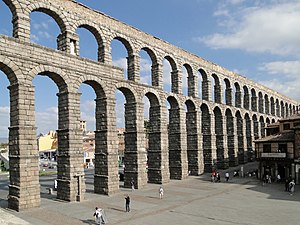Aqueduct of Segovia
| Old Town of Segovia and its Aqueduct | |
|---|---|
| Name as inscribed on the World Heritage List | |
 |
|
| Location | Spain |
| Type | Cultural |
| Criteria | i, iii, iv |
| Reference | 311 |
| UNESCO region | Europe and North America |
| Inscription history | |
| Inscription | 1985 (9th Session) |
The Aqueduct of Segovia (or more precisely, the aqueduct bridge) is a Roman aqueduct in Segovia, Spain. With the Pont du Gard in France, it is one of the best-preserved elevated Roman aqueducts. It is the foremost symbol of Segovia, as evidenced by its presence on the city's coat of arms.
As the aqueduct lacks a legible inscription (one was apparently located in the structure's attic, or top portion), the date of construction cannot be definitively determined. The general date of the Aqueduct's construction was long a mystery although it was thought to have been during the 1st century AD, during the reigns of the Emperors Domitian, Nerva, and Trajan. At the end of the 20th century, Géza Alföldy deciphered the text on the dedication plaque by studying the anchors that held the now missing bronze letters in place. He determined that Emperor Domitian (AD 81-96) ordered its construction and the year 98 A.D. was proposed as the most likely date of completion. However, later evidence found in 2016 points out to a slightly later date, by 112 AD.
The beginnings of Segovia are also not definitively known. The Vaccaei people are known to have populated the area before it was conquered by the Romans. Roman troops sent to control the area stayed behind to settle there. The area fell within the jurisdiction of the Roman provincial court (Latin conventus iuridici, Spanish convento jurídico) located in Clunia.
The aqueduct once transported water from the Rio Frio river, situated in mountains 17 km (11 mi) from the city in the La Acebeda region. It runs 15 km (9.3 mi) before arriving in the city.
The water was first gathered in a tank known as El Caserón (or Big House), and was then led through a channel to a second tower known as the Casa de Aguas (or Waterhouse). There it was naturally decanted and sand settled out before the water continued its route. Next the water traveled 728 m (796 yd) on a one-percent grade until it was high upon the Postigo, a rocky outcropping on which the old city center, the Segovia Alcázar, was built. Then, at Plaza de Díaz Sanz (Díaz Sanz Plaza), the structure makes an abrupt turn and heads toward Plaza Azoguejo (Azoguejo Plaza). It is there the monument begins to display its full splendor. At its tallest, the aqueduct reaches a height of 28.5 m (93 ft 6 in), including nearly 6 m (19 ft 8 in) of foundation. There are both single and double arches supported by pillars. From the point the aqueduct enters the city until it reaches Plaza de Díaz Sanz, it includes 75 single arches and 44 double arches (or 88 arches when counted individually), followed by four single arches, totalling 167 arches in all. The construction of the aqueduct follows the principles laid out by Vitruvius as he describes in his De Architectura published in the mid-first century.
...
Wikipedia
